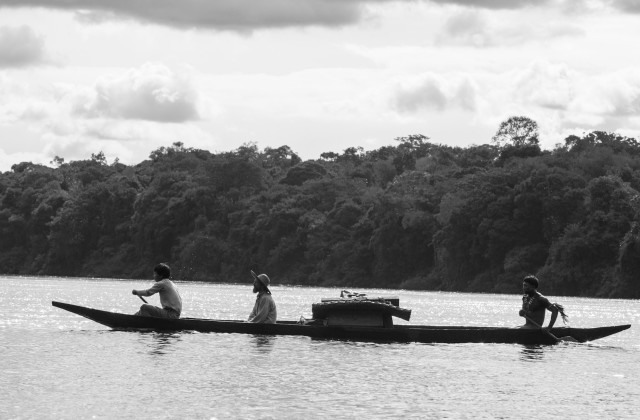Hans Morgenstern tangles with ‘Embrace of the Serpent’ in 2-part intervierw with director, in-depth Reverse Shot review
FFCC Vice Chair Hans Morgenstern spoke to Colombian writer/director Ciro Guerra about his mystical masterpiece and Oscar-nominated film Embrace of the Serpent in a two-part. His in-depth review can also be read in Reverse Shot.
Last week, Embrace of the Serpent, a movie that will certainly go down as one of the best films that saw release in the United States in 2016, started playing in area art houses in South Florida. This writer caught it last year as part of “Gems,” an annual mini film festival hosted by Miami Dade College’s Miami International Film Festival. For the most part, during the weekend-long event, I could tell when I saw excellent work (The Assassin, My Golden Days) and rather problematic work (Youth, The Club). But Embrace fell into another kind of category as far as cinematic experiences go. It confounded me. I knew I saw a brilliant film, though I did not understand how it worked as well as it did. It reminded me of the first time, back in 1999, when I saw Eyes Wide Shut in theaters. I knew I saw another masterpiece by Stanley Kubrick, though I could not express exactly why it was so great. Several viewings later, having read the source material and written about it during my master’s degree, I came to understand it better and admire it deeper (I promise to publish the Lacanian analysis I wrote of the film by the end of the year).
It was a similar experience with Embrace of the Serpent. It took a second and even a third viewing before I could confidently understand what a masterpiece this film was. In speaking with at least four other film critics, over the months since I first saw the movie, I learned I was not the only with that same experience.
With it’s commercial release in 2016 last month by the marvelous indie studio Oscilloscope, it came time to reckon with this movie. I was honored that Michael Koresky of Film Comment, Criterion Collection and now Metrograph fame, allowed me to tangle with a close reading of it on Reverse Shot, the website he co-edits with Jeff Reichert. You can read my in-depth and somewhat spoilery review (but I think it will enhance a first time viewing, if you don’t want to invest in seeing it more than once) by jumping through the site’s logo below:
As the film headed to Miami, earlier this month, I also could not pass on an opportunity to speak to the film’s director Ciro Guerra, who helped clarify some questions I had about it. Guerra explained that he wanted to respect the culture he represents on the big screen. His research was extensive, including spending months in parts of the Amazon. After reading two books written by two early 20th century European explorers of the region, the German ethnographer Theodor Koch-Grünberg and the ethnobotanist Richard Evans Schultes, he came up with the film’s dual narrative with co-screenwriter Jacques Toulemonde Vidal.
The film’s stories unfold by alternating between the narratives, one at the start of the 20th century and the other 40 years into the future. The film’s lead character is Karamakate, played by two native, non-actors, Nilbio Torres and the elder Antonio Bolivar, as he guides two different explorers based on the authors of the books Guerra used for research (Jan Bijvoet and Brionne Davis) on similar journeys in search of a near extinct plant with hallucinogenic properties called the yakruna. And don’t bother looking up yakruna. Its name was made up for the movie. “The Shaman asked to keep it fictional because those names are sacred,” said the director, speaking via phone from his home country of Colombia. “You shouldn’t learn them from a movie,” he added…
(Read more on Independent Ethos)



